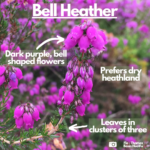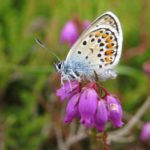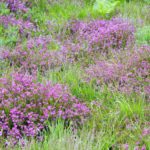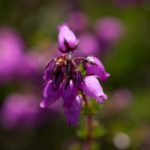Bell Heather

Back Cross-leaved Heath Common Heather Bell Heather Common Gorse Dwarf Gorse Sundew
BELL HEATHER
Erica cinerea
Turning hillsides pink in late summer, Bell Heather’s name is derived from its bell-shaped flowers. It is a major source of nectar for many kinds of insects, including the rare Silver-studded Blue butterfly.
Its dark-pink, bell-shaped flowers are very distinctive, as are the dark green, needle-like leaves arranged in clusters along the stems. Although superficially similar to Cross-leaved Heath, its flowers are smaller and form clusters along the stem, rather than on just one side.
- Silver-studded Blue butterfly by Michael Jones
- Warden Flo looked at three types of heather on her “Brilliant Botany” walk at Sheets Heath. This one’s the most vivid pink, it’s called Bell Heather and is found in drier areas.
- Bell Heather by Martin D’Arcy
- Bell Heather by Jonathan Shavelar
[Click on the thumbnails to open]
Where/when to find it
Flowering from July to September, Bell Heather is found across a range of habitats, including heathland, moorland and coastal regions. It is particularly happy on dry, well-drained acidic soils.
Adaptations
Often the primary coloniser after burning, it is frost-resistant, and can tolerate acidic soils. Its narrow needle-like leaves minimise water loss.
Rarity
It is common throughout the UK.
Read more
On Plant Life’s website: Bell Heather
#MoreThanJustNightjars





